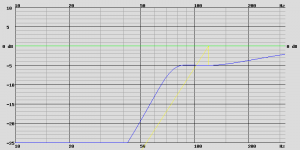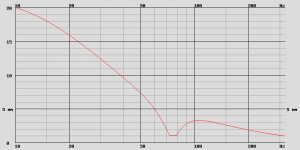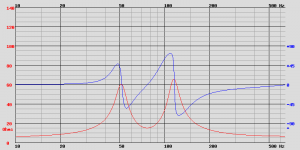To make things clear: I didn't lower anything. I was using these drivers with this crossover frequency from the beginning.
Why would I have to attenuate the higher frequencies compared to crossing at 900 Hz ? What I had to use was a dip below 3 kHz and one around 10 kHz.
Regarding FM: Because I lowered the x-over frequency the bandwidth demand on my woofers was reduced and therefore their FM distortion lowered.
Regards
Charles
Why would I have to attenuate the higher frequencies compared to crossing at 900 Hz ? What I had to use was a dip below 3 kHz and one around 10 kHz.
Regarding FM: Because I lowered the x-over frequency the bandwidth demand on my woofers was reduced and therefore their FM distortion lowered.
Regards
Charles
Hi turk. I've been using coax CD's on small/mid size commercial horns crossed at 650Hz for over 5 years, both as home hi-fi, and PA for many hundreds of folks.
Beautiful sound. No more HF attenuation needed crossing at 650Hz than at say 900Hz. Loud with no problems at all.
For the last 2 years, working on large synergies which load the same CD lower in freq than the commercial horn, I've moved xover down to as low as 480Hz, again with stellar results, and also at high SPL.
But the lower xover point on the synergies was more to be able to avoid the use of small 4-5" mid drivers that typically form a bridge in a synergy, between woofer and CD.
Sometimes I contemplate adding 4-5" mids, despite having achieving a personal best sound without them (that is maybe the best I've heard anywhere).
I contemplate it, because my gut feel is that no driver should be asked to pull more than a decade of duty, 3 octaves, for realistic SPL and dynamics.
And the lower CD cross point asks the lower coax section to pull 4 octaves.
I believe keeping a driver's span within 3 octaves applies both high and low....though out the spectrum.
Heck, i like keeping it under 2 &1/2 octaves per driver and am thinking about going 5 way (with the small mids for a syn)
So i guess i just made a longwinded statement of agreement with you. 🙂
Beautiful sound. No more HF attenuation needed crossing at 650Hz than at say 900Hz. Loud with no problems at all.
For the last 2 years, working on large synergies which load the same CD lower in freq than the commercial horn, I've moved xover down to as low as 480Hz, again with stellar results, and also at high SPL.
But the lower xover point on the synergies was more to be able to avoid the use of small 4-5" mid drivers that typically form a bridge in a synergy, between woofer and CD.
Sometimes I contemplate adding 4-5" mids, despite having achieving a personal best sound without them (that is maybe the best I've heard anywhere).
I contemplate it, because my gut feel is that no driver should be asked to pull more than a decade of duty, 3 octaves, for realistic SPL and dynamics.
And the lower CD cross point asks the lower coax section to pull 4 octaves.
I believe keeping a driver's span within 3 octaves applies both high and low....though out the spectrum.
Heck, i like keeping it under 2 &1/2 octaves per driver and am thinking about going 5 way (with the small mids for a syn)
So i guess i just made a longwinded statement of agreement with you. 🙂
Wouldn't it be better to argue about something more important than FM in loudspeakers - like whether or not running the shower affects the HF response of a CD.
Wouldn't it be better to argue about something more important than FM in loudspeakers - like whether or not running the shower affects the HF response of a CD.
Haha...i often feel that way about the scrutiny given to waveguide propagations 😀
Earl - You're right! My Compact Discs sound waaaay better when I'm running the shower. The sound is much more, I don't know, liquid...
Sorry. I couldn't resist.
Sorry. I couldn't resist.
Hot Rod 8” 2-Way PA/Studio Monitor
Model the Fb in a simulator, go with a large enough port that does not "blow wind" at Xmax.
Art
A considerable amount of low end boost is required to get 35Hz out of the 8NDL64 in those cabs.
Attachments
and as we've still no metric to the correlation between distortion and perception why should discussions of such be verboten? (sorry for violating forum rules: use of another language but english)
We could argue group delay some more...Ive got a long response from Martin King on how group delay has nothing to do with "time"...I dont know what to make of it yet, but he seems pretty insistent 🙂
Interesting viewpoint.
In signal processing group delay τ g is defined as the derivation of the phase response ϕ of a device or medium with respect to frequency f.
and
"As group delay is defined in the frequency domain, its time-domain nature is unknown. Owing to its time-domain nature being unknown, group delay is confused with the concepts of the propagation delay. By studying the time-domain nature of group delay, the difference between group delay and propagation delay is revealed. As group delay is different from the propagation delay, neither the superluminality nor negativity of group velocity defies the special relativity or casualty."
In signal processing group delay τ g is defined as the derivation of the phase response ϕ of a device or medium with respect to frequency f.
and
"As group delay is defined in the frequency domain, its time-domain nature is unknown. Owing to its time-domain nature being unknown, group delay is confused with the concepts of the propagation delay. By studying the time-domain nature of group delay, the difference between group delay and propagation delay is revealed. As group delay is different from the propagation delay, neither the superluminality nor negativity of group velocity defies the special relativity or casualty."
Last edited:
We could argue group delay some more...Ive got a long response from Martin King on how group delay has nothing to do with "time"...I dont know what to make of it yet, but he seems pretty insistent 🙂
Group delay is measured in seconds, that seems like time to me.
"As group delay is different from the propagation delay, neither the superluminality nor negativity of group velocity defies the special relativity or casualty."
Wow, now there's a statement that does not appear to mean anything.
yep it's like trying to get a math to english translation so that a correlation can be established...
More fun ! Lol
Here's my kindest thoughts about group delay....
Group Delay is an oxymoron at best.
There's nothing 'group' about it.
And there's not even any real time delay, other than underlying frequency-dependent phase warp.
Imho, it's a worthless, misleading concept for tuning/crossover work.
It's an unfortunate term, one that audio would be better off having never heard....
Anybody wanna hear the 'mean' version , haha
Here's my kindest thoughts about group delay....
Group Delay is an oxymoron at best.
There's nothing 'group' about it.
And there's not even any real time delay, other than underlying frequency-dependent phase warp.
Imho, it's a worthless, misleading concept for tuning/crossover work.
It's an unfortunate term, one that audio would be better off having never heard....
Anybody wanna hear the 'mean' version , haha
and as we've still no metric to the correlation between distortion and perception
This is exactly what Earl did with the gedlee metric
The Gedlee Metric Demystified
An interesting video with Earl and Erin where there is some discussion surrounding this topic included
(Informal) Chat with Dr. Earl Geddes of GedLee Audio | Audio Science Review (ASR) Forum
Wow, now there's a statement that does not appear to mean anything.
It does, wrt electronic circuits, optical fibers etc.
That post was about group delay in signal processing, as mentioned.
Last edited:
Here's my kindest thoughts about group delay....
Group Delay is an oxymoron at best.
There's nothing 'group' about it.
And there's not even any real time delay, other than underlying frequency-dependent phase warp.
Imho, it's a worthless, misleading concept for tuning/crossover work.
It's an unfortunate term, one that audio would be better off having never heard....
Short and sweet, Mark 😀
It does, wrt electronic circuits, optical fibers etc.
That post was about group delay in signal processing, as mentioned.
As an expert in signal processing I'd still have to say that it doesn't make any sense. Especially not as applied to acoustics. That is what we are talking about right? Group delay is a very real and pertinent effect in signal processing - discount it at your own peril.
It is and I don't discount it 😉
That said, as far as fairly simple domestic loudspeaker systems are concerned, I wouldn't lose any sleep over group delay.
It's different for complex installations and live sound.
This is the research paper that I quoted, it's not related to acoustics though.
That said, as far as fairly simple domestic loudspeaker systems are concerned, I wouldn't lose any sleep over group delay.
It's different for complex installations and live sound.
This is the research paper that I quoted, it's not related to acoustics though.
Attachments
Last edited:
It is and I don't discount it 😉
This is the research paper that I quoted, it's not related to acoustics though.
Cheers Roland

I don't discount it either; I simply pay attention to phase and eliminate it 😉
Thanks for that paper. With the recent experiments I've been doing with wavelets, much of it even made sense ! Lol
Exploring observed negative group delay, asking how can that not defy causality and imply a transfer function operating faster than the speed of light, was downright philosophically interesting.
- Home
- Loudspeakers
- Multi-Way
- Is it possible to cover the whole spectrum, high SPL, low distortion with a 2-way?


